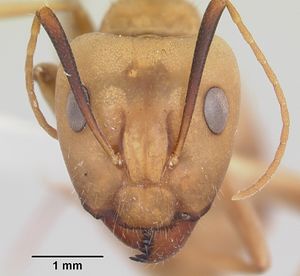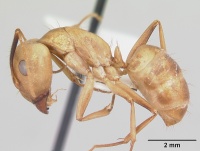Camponotus absquatulator
| Camponotus absquatulator | |
|---|---|

| |
| Scientific classification | |
| Kingdom: | Animalia |
| Phylum: | Arthropoda |
| Class: | Insecta |
| Order: | Hymenoptera |
| Family: | Formicidae |
| Subfamily: | Formicinae |
| Tribe: | Camponotini |
| Genus: | Camponotus |
| Species: | C. absquatulator |
| Binomial name | |
| Camponotus absquatulator Snelling, R.R., 2006 | |
Alate queens have been collected at lights during the months of June and July. This species nests in soil and is nocturnal, in lowland habitats ranging from Saltbush Scrub to Creosote Scrub (Snelling 2006).
Identification
Similar to Camponotus festinatus but overall size smaller; differs from all other members of the C. festinatus complex by the lack of erect setae along the head margins posterior to level of anterior margin of the compound eyes in both major worker and queens; minor workers usually lack such setae along the entire head margin.
Distribution
In addition to the type series I have examined specimens from the following localities. Mexico, Baja California: Cañon de Guadelupe, 350 m. United States of America, Arizona, Yuma Co.: Yuma. California, Imperial Co.: Bard, Brawley, Calipatria, El Centro, Holtville (8 mi E), Winterhaven. Riverside Co.: Blythe, Indian Wells, Palm Springs. (Snelling 2006)
Distribution based on Regional Taxon Lists
Nearctic Region: United States (type locality).
Neotropical Region: Mexico.
Distribution based on AntMaps
Distribution based on AntWeb specimens
Check data from AntWeb
Countries Occupied
| Number of countries occupied by this species based on AntWiki Regional Taxon Lists. In general, fewer countries occupied indicates a narrower range, while more countries indicates a more widespread species. |

|
Estimated Abundance
| Relative abundance based on number of AntMaps records per species (this species within the purple bar). Fewer records (to the left) indicates a less abundant/encountered species while more records (to the right) indicates more abundant/encountered species. |

|
Biology
Castes
Worker
Images from AntWeb
   
| |
| Worker. Specimen code casent0103107. Photographer April Nobile, uploaded by California Academy of Sciences. | Owned by LACM, Los Angeles, CA, USA. |
Images from AntWeb
   
| |
| Worker. Specimen code casent0103106. Photographer April Nobile, uploaded by California Academy of Sciences. | Owned by LACM, Los Angeles, CA, USA. |
Nomenclature
The following information is derived from Barry Bolton's Online Catalogue of the Ants of the World.
- absquatulator. Camponotus absquatulator Snelling, R.R. 2006: 88, figs. 12-17 (s.w.q.) U.S.A. (California).
Unless otherwise noted the text for the remainder of this section is reported from the publication that includes the original description.
Description
Worker
Major. (n = 12). Measurements: HL 2.46-2.67; HW 2.26-2.51; EL 0.59-0.67; SL 2.00-2.21; ML 2.82 - 3.23. Indices: CI 92-96; HFI 94-98; OI 24-25; SI 81-86.
Medium-sized species in the C. festinatus complex. Head similar to that of Camponotus festinatus but sometimes more rotund in frontal view. Mandible shiny and weakly microreticulate throughout between scattered piligerous punctures; masticatory margin with six teeth, the first five acute and the proximal tooth bluntly rounded to truncate. Malar area with scattered round punctures, elon-gate punctures, if present, confined to near base of mandible. EL about 0.33 × HL in frontal view, outer eye margin separated from head margin by less than one-half eye width; ICD 0.57 - 0.60 × HW. Midline of clypeus weakly subangulate but more strongly so near posterior margin; an-terior margin broadly transverse. Scape and frontal carinae as described for C. festinatus.
Mesosoma as described for C. festinatus, but only mesometanotal line present across dorsum. Petiole and legs as des-cribed for C. festinatus, but metafemur not over 2.3 mm long.
Sculpture of head and body similar to C. festinatus but malar area with scattered round punctures only.
Pilosity similar to that of C. festinatus but head margins, posterior to anterior margin of eyes without erect setae; side of pronotum, near ventral margin, without erect hairs; the following numbers of medium to long yellowish setae present on indicated surfaces: dorsal face of scape shaft (3-8), ventral margin of profemur (5-8), pronotum (9-15), mesonotum (6-10), propodeum (4-7), petiole (6-8), disc of gastral tergum I (5-7), premarginal row on gastral tergum I (8-10). Fine appressed pubescence absent or nearly so, from all surfaces except sparse and difficult to see on scape shaft.
Color light yellowish brown; scape and tibiae darker; mandibles reddish; gastral segments sometimes with darker infuscation.
Media and minor. (n = 21). Measurements: HL 1.54-1.64; HW 1.08-1.18; EL 0.46-0.49; SL 1.79-1.90; ML 2.26-2.36. Indices: CI 70-72; HFI 137-235; OI 30; SI 113-120.
Head shape about as in C. festinatus; ICD 0.60-0.70 × HW. Mesosoma about as described for C. festinatus.
Pilosity similar to C. festinatus but usually lacking short erect setae along head margins, rarely 1-3 on anterior ma-lar area near mandible base. Standing yellowish setae present on indicated surfaces: dorsal face of scape shaft (0-2), ventral margin of profemur (2-5), pronotum (3- 6), mesonotum (2-4), propodeum (2), petiole (3-6), disc of gastral tergum I (2-6), premarginal row on gastral tergum I (4-6).
Color yellowish, mandible, scape, all tarsi pale brownish and at least first gastral tergum with obscure marginal brownish band.
Queen
(n = 3). Measurements: HL 2.36-2.51; HW 2.10-2.36; EL 0.67-0.77; SL 1.95-2.10; ML 3.95-4.15. Indices: CI 89-94; HFI 102-110; OI 28-33; SI 83-87.
Similar to queens of C. festinatus but smaller and with shorter scape and legs. In frontal view, outer margins of eyes do not exceed lateral margins of head. Outer head margins without erect setae behind level of anterior eye margins; malar area with short erect setae on anterior one-half or less. ICD 0.68-0.75 × HW; EL 0.68-0.75 × OMD; IOD 3.20-3.40 × OD; OOD 3.20-3.60 × OD.
Type Material
(major worker). United States of America, California, Imperial County: 3 mi (4.8 km) E of Imperial, -21 m, 4.V.1956, leg. R.R. Snelling, under wood on ground (Los Angeles County Museum of Natural History). Paratypes. 59 major and minor workers and 1 alate queen with same data (The Natural History Museum, LACM, Museum of Comparative Zoology, University of California, Davis).
Etymology
From Latin, one who runs away, in allusion to the alacrity with which these ants run away when disturbed.
References
- Alatorre-Bracamontes, C.E., Vásquez-Bolaños, M. 2010. Lista comentada de las hormigas (Hymenoptera: Formicidae) del norte de México. Dugesiana 17(1): 9-36.
- Snelling, R. R. 2006. Taxonomy of the Camponotus festinatus complex in the United States of America (Hymenoptera: Formicidae). Myrmecologische Nachrichten. 8:83-97.
References based on Global Ant Biodiversity Informatics
- Snelling R. R. 2006. Taxonomy of the Camponotus festinatus complex in the United States of America (Hymenoptera: Formicidae). Myrmecologische Nachrichten 8: 83-97
- Vásquez-Bolaños M. 2011. Lista de especies de hormigas (Hymenoptera: Formicidae) para México. Dugesiana 18: 95-133

